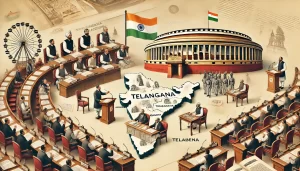The Telangana movement’s journey towards statehood was a long and arduous one, punctuated by intense parliamentary debates, political maneuvering, and public pressure. The parliamentary process, though fraught with delays and setbacks, ultimately paved the way for the creation of Telangana as India’s 29th state in 2014.
Early Parliamentary Initiatives
The demand for a separate Telangana state had been raised in Parliament as early as the 1960s. However, it was not until the late 2000s that the issue gained significant traction in the legislative arena. In 2009, following widespread protests and agitations, the then Home Minister, P. Chidambaram, announced the initiation of the process for the formation of Telangana.
The Srikrishna Committee
In 2010, the central government appointed a committee headed by Justice B.N. Srikrishna to examine the demand for Telangana and to suggest a course of action. The committee submitted its report in 2011, outlining six Options, including the creation of a separate Telangana state with Hyderabad as its capital.
Political Gridlock
The Srikrishna Committee report, however, did not lead to any immediate action. The issue remained mired in political gridlock, with strong opposition from those who favored a united Andhra Pradesh. The ruling Congress party, which was divided on the issue, struggled to find a consensus.
The Bill for Telangana
In 2013, after months of intense deliberations, the Congress party finally decided to move forward with the creation of Telangana. A bill for the bifurcation of Andhra Pradesh was drafted and introduced in Parliament.
Parliamentary Debates
The bill for Telangana faced stiff resistance from the Seemandhra region (the remaining part of Andhra Pradesh). The debates in Parliament were heated and emotional, with MPs from both sides presenting their arguments forcefully.
The Telangana MPs argued that the region had been historically neglected and discriminated against, and that the creation of a separate state was the only way to ensure its development and progress. They also highlighted the strong public sentiment in favor of statehood.
The Seemandhra MPs, on the other hand, argued that the bifurcation of Andhra Pradesh would be detrimental to the interests of both regions. They expressed concerns about the sharing of Resources, especially water, and the status of Hyderabad, which was the capital of the united state.
Passage of the Bill
Despite the opposition, the bill for Telangana was passed by the Lok Sabha (the lower house of Parliament) in February 2014. The bill was then sent to the Rajya Sabha (the upper house), where it faced further hurdles.
In a controversial move, the bill was passed by the Rajya Sabha through a voice vote, amid uproar and protests from the Seemandhra MPs. This led to allegations that the government had bypassed parliamentary procedures to push through the bill.
President’s Assent
The bill, after being passed by both houses of Parliament, was sent to the President for his assent. President Pranab Mukherjee gave his assent to the bill on March 1, 2014, paving the way for the creation of Telangana as India’s 29th state.
The Aftermath
The creation of Telangana was met with jubilation in the Telangana region, while it sparked protests and disappointment in Seemandhra. The new state, born out of a long and arduous struggle, embarked on a path of development and progress, seeking to fulfill the aspirations of its people.
The Parliamentary Process: A Critical Appraisal
The parliamentary process in the Telangana movement was a complex and often contentious one. While it ultimately led to the creation of a new state, it also raised questions about the fairness and transparency of the process.
The use of a voice vote in the Rajya Sabha to pass the bill for Telangana was particularly controversial. Critics argued that this bypassed the normal parliamentary procedures and denied the Seemandhra MPs an opportunity to voice their concerns.
Despite these criticisms, the parliamentary process in the Telangana movement was a landmark event in Indian Democracy. It demonstrated the power of public opinion and the ability of a mass movement to influence the legislative process. The creation of Telangana also set a precedent for the formation of new states in India based on popular demand.
